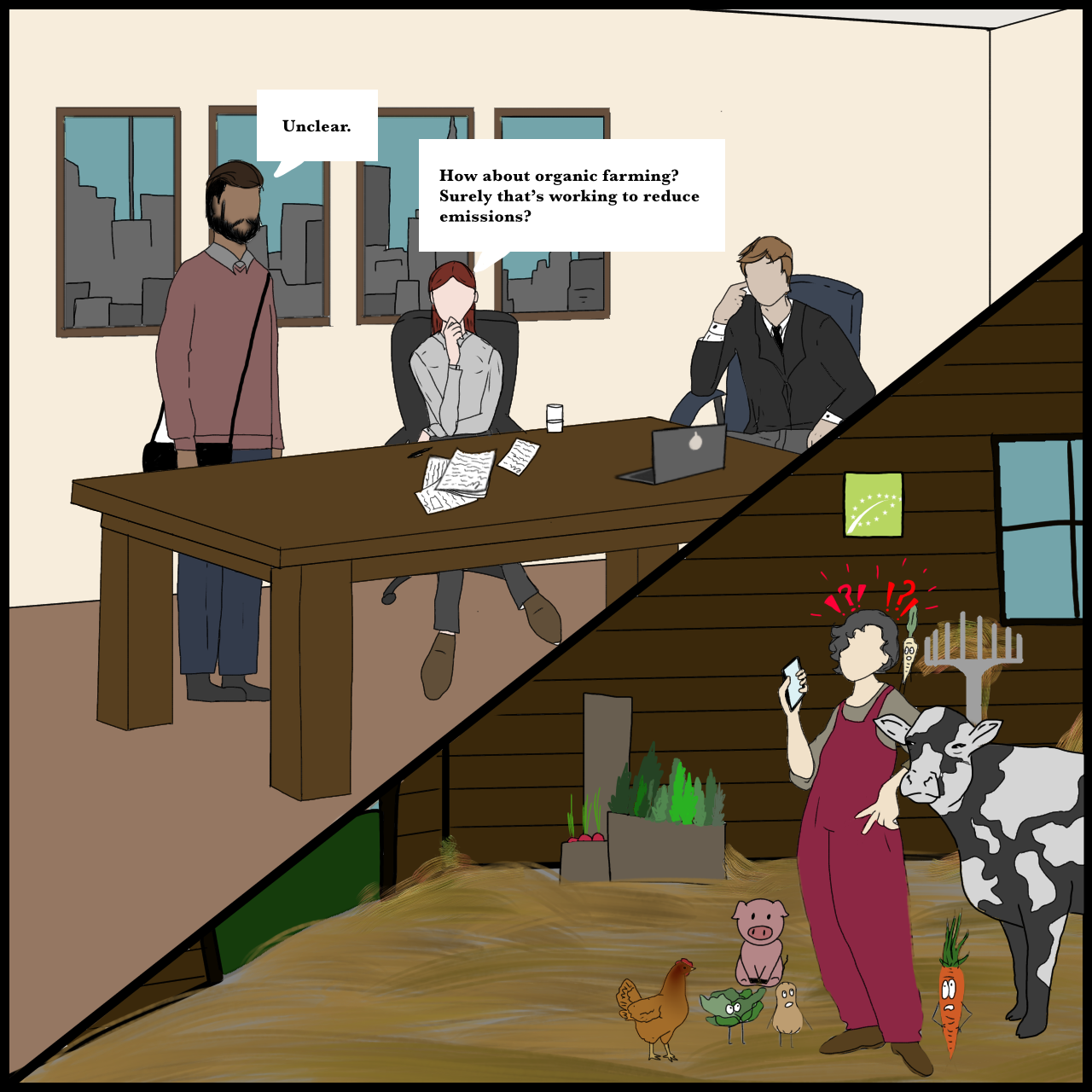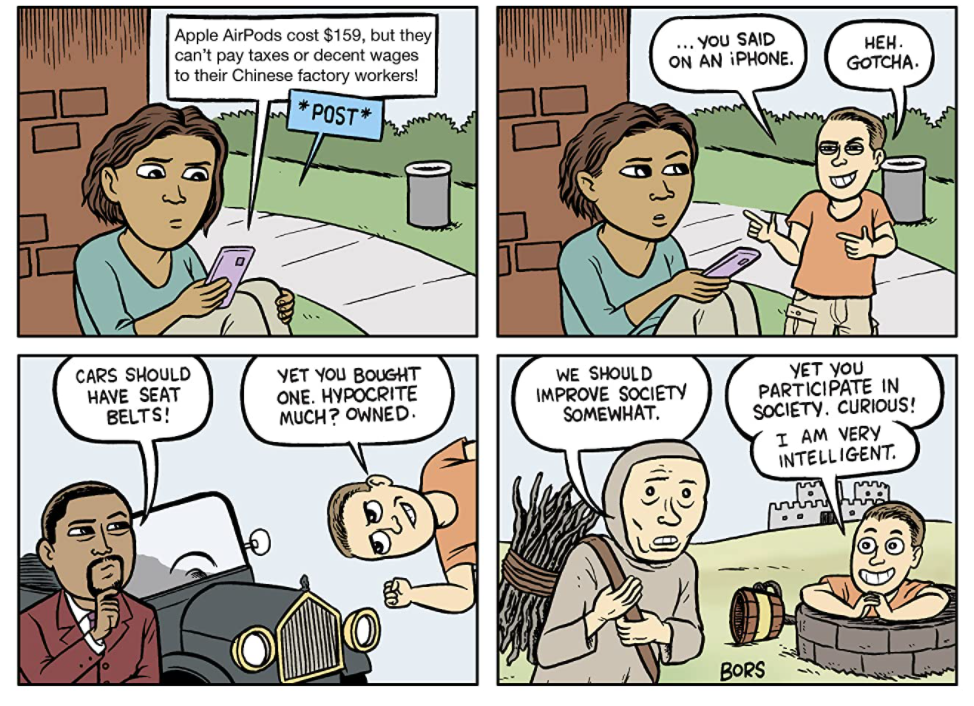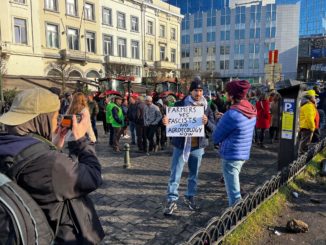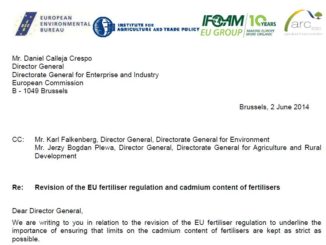The European Court of Auditors (ECA) has an impeccable record in assessing CAP from a number of important perspectives. We’ve covered this many times here on ARC2020. The auditor’s most recent relevant report on CAP and climate, outlines a host of serious issues and a under performances by the policy, while also making some suggestions for big, achievable climate wins. However, we in ARC2020 were a little taken aback by how the paper treated organic farming – funded as it is under CAP – and its climate impact. Below Oliver moore unpacks what he finds to be a rare misstep by the ECA, with issues such as double standards, limited sourcing, and a constrained understanding of or vision for farming and the rural areas it happens on.
What do the auditors say about organic farming?
As part of an overall assessment of CAP and its climate impact, organic farming is described as having an ‘unclear’ impact. Special report 16/2021 also more specifically states that the organic farming has received “considerable CAP support” with its “effectiveness to mitigate climate change unclear”.
To quote the relevant section in full:
Organic farming does not allow the use of chemical fertilisers. However, the conversion of conventional to organic farming does not necessarily lead to reduced greenhouse gas emissions. There are two main conversion scenarios, both putting in doubt whether the expansion has reduced greenhouse gas emissions:
o If a conventional farmer with low fertiliser use (such as upland grazing) converts to organic farming, the impact on emissions will be low.
o If a farmer with higher fertiliser use converts to organic farming, the farm’s emissions will be significantly reduced. However, lower yields on organic farms may induce other farms to use additional fertiliser or land to produce – and emit more.
Below a link to the first part of this two part series, this article lists and explain a number of reasons why the ECA have misunderstood the context of organic farming, livestock reductions, and some other considerations.
The current yield is unsustainable
Yes, sometimes, in some categories, organic farming producers a lower yield. It is argued that this initsle encourages (induces) more production elsewhere. But first up, the yield we currently generate has huge problems. With biodiversity collapse, runaway climate change, chronic rural depopulation, soaring pollutions and human health and poverty realities, business as usual in farming and food isn’t an option. Yes lots of people are fed, but there are a range of huge punches landing on the body of people and planet. We can’t carry on as is. Emphasising yield makes a presumption that the current high conventional yields are both stable and sustainable. We banned DDT, growth hormones (n Europe), paraquat, neonicotinoids, and each time, business-as-usual claimed that this would reduce yield. But we still had to do it – every time. There is nothing to suggest this trend will end, with for example glyphosate, nanoparticles, gene editing and a host of other areas under regulatory pressure right now.
So this yield, as it’s currently achieved, is in many ways extremely destructive for the quality of our air, water, soil and biodiversity. Year after year, pressure is exerted on farming to reduce certain harmful pesticides, to reduce fertilizer use, to improve animal welfare standards – and with good reason. But there are always societal trade offs – no one need trumps all others. Greater animal welfare standards, for example, increases the space available to animals, which increases the space production takes up, and reduces the carbon efficiency of production. But this is what society is demanding. This process inevitably, moves the yield performance close to the organic performance, as, often, its drawing from the organic handbook. This is the case with all of the examples cited above – the pesticides, herbicides, fertilizers and animal welfare standards.
It’s interesting to see how the yield of certain products, when externalities are taken more seriously, changes. The yield gap between conventional and organic milk in the Netherlands, for example, is almost nil. With Nitrogen rules derogations – which the ECA site as problematic, of course conventional yields from livestock sources are higher. But why, in the context of rising water pollution and climate impacts, do we persist in allowing some derogations- read, exemptions from the rules subject to some increased measures – persist? (More on this conundrum here).
Summary – comparing organic and conventional yields presumes we can continue to do the damage the conventional yield does. We can’t.
Yes, we should improve society somewhat
We should indeed improve society somewhat – even if there are short terms knocks and shocks and necessary adjustments. Many climate focused environmental NGOs argue for dietary change plus agroecological practices these days, precisely because the current yield is unsustainable. The European Environmental Bureau (EEB) for example, is made up of “170 member organisations in more than 35 countries (all EU Member States plus some accession and neighbouring countries)”. Even in a climate change mitigation context – responding in this case to the “Fit for 55” European Commission climate policy framework, it argues for:
“a clear pathway to net-zero emissions in agriculture. The EEB’s vision showcases how the transition to agroecology, accompanied by a shift towards healthier and more sustainable diets, can answer our climate challenges and contribute to the restoration of biodiversity and food systems.”
Certified organic farming is the cornerstone practice for what we now know of as agroecology. Organic is a great – perhaps the ultimate – all rounder we have at present, notwithstanding the need to bring in or add on labour standards. Here the case is made for a wide spectrum of socio-environmental positives which can be delivered via organic farming and food – see also here and the accompanying image below, from Regenold and Wachter.
All these considerations need to come in with dietary change. Given the wide ranging environmental needs we have, and how much land farming takes up, we need a per hectare (ha) and a per kilo (kg) approach to emissions too, not just a per kg approach. We need both or else we risk destroying many socio-environmental positives to achieve one. Studies on feeding the entire planet sustainably have found that many core changes we need to be making anyway can happen in conjunction with a 100% transition to organic farming.
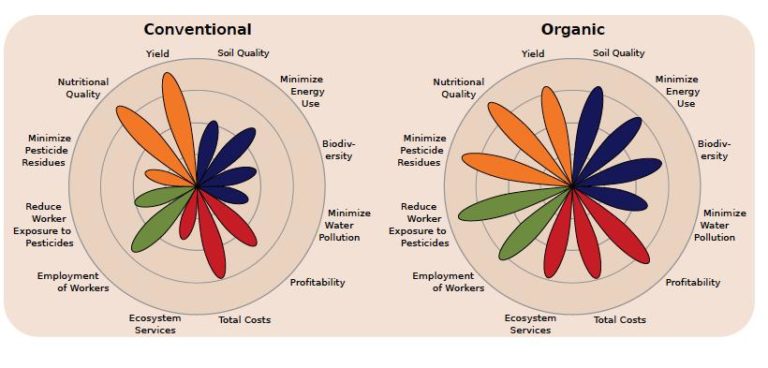
Summary: Change is coming and necessary, organic can lead the way.
Dietary change
Some level of dietary change then, especially in high consumption western countries and higher socio-economic classes everywhere – is needed – and coming. If it doesn’t we will continue to steer the titanic towards the iceberg. In this context, should we be spending money stimulating high emissions diets? Also, dietary change will come from regulatory change as much as trends. Limits on mineral fertilizers and pollutants, changes in animal welfare standards are just two examples. So as well as societal pressure, there will need to be ever-more be internal EU and also trade regulatory pressure brought to bear on the externalities-laiden conventional diet. Continuing business-as-usual is not a solution. To repeat – we need to make several adjustments, for the sake of biodiversity, pollution, climate, poverty alleviation and more – concurrently. There is no real solution offered in the whataboutery of increasing efficiency and avoiding the hard work of transitioning – there is only the titanic being steered towards that iceberg.
Summary – regulatory change is part of dietary change and this hard work needs to continue.
Grow organics, grow its yield
With adequate Research and Development investment in organics, proportional to member state and EU growth figures, organic will improve its yield. Indeed organic, as it were, improves with age both as resilient farming (resisting pests, being more and more nutritious) and as an ever higher yielding practice – see the evidence cited in this article of ours for yield increases over time (we also outline in more detail the per kg vs per ha arguments in this article). However its more than just R&D – the new organic regulation will also for more organic-adapted seeds to be used in the system, which heretofore has not been the case. Organic has thus far tried to exist in a food regime tailored towards conventional agriculture, from agronomic to marketing ends of the spectrum. Similarly, supports to grow organics must be full-spectrum too – encompassing all significant areas from field to consumer at one and the same time.
“Here is a need for a comprehensive full agri-food system approach to developing organics at policy, production, research, extension services, processing, distribution, advocacy and consumption ends. These must be done simultaneously and publicly, so as to develop confidence in the sector. This should be coupled with the levelling of the playing field by fully complying with EU and national environmental law and targets in water quality, reducing absolute emissions, and more”.
To this end, the Horizon Europe plan to allocate 30% of its far budget to organic is a welcome step. – and one that is at variance with how things have been thus far. The idea, indeed, that organic has received “considerable” CAP support would be very much questioned by organic farmers and their certification bodies. See here for e.g. from IFOAM EU on what would actually be needed to reach EU Green Deal Targets.
Also however, the “two main conversion scenarios” for organic must be queried. While there is often a lack of comparable data in CAP related activities, there are more scenarios of people getting involved in organics than high productive farmers leading to leakage when converting, and extensive (presumably livestock) farmers converting to an already similar system. Organics also attracts people into farming in the first place; attracts mixed horticulturalists especially those who may not have farmed at all otherwise; creates more employment per hectare and is more diversification and value adding ready; has a younger and more educated profile, and other more socio-economic variables (see page five here, drawing from organic farming as described in the EU Biodiversity Plan for some examples).
In other words, if and when the EU develops the overall organic agri-food system sustainably, far more than those two scenarios emerge. But even the extensivist scenarios, by getting an organic premium, their viability increases, as does the overall viability of the sector. ( note – it’s not always the case that they can ,but see the need for comprehensive food system development). There is even evidence that neighbours influence neighbours in a supportive environment, including as diffusion of innovation and in technology adaptation, with organic a form of technology (examples over a 20 year period includes these here here here and here).
Summary – there has never been a level playing field for organics; make it so and watch it grow.
Two papers are not enough
Perhaps the weakest part of the ECA critique of organic as providing unclear evidence of ghg mitigation is the citations. There are but two papers. Of these, one falls into the per kg vs per ha ongoing debate: as outlined here, this debate has been ongoing for years and is unlikely to be resolved soon as it’s about two paradigms clashing fundamentally. Unsuprisingly, it has the usual emphasis on maintaining diets as they are, thus ensuring carbon leakage if there is any conversion to organic of significance. The other, strangely, is a sole-authored paper with as expressly anti-organic bias. Kirchman (2019) is one of only two papers cited by the ECA and this paper emphasises the yield gap too. This sole authored paper describes itself as “outspoken” against organic, making it a strange choice, of the many many available, which make the standard arguments. And yet, this represents fully half of the cited papers on this important argument the ECA makes.
Summary – More citations please!
So much space for nature – really?
The idea that if we hyper-industrialise farming and ramp up yields we will then inevitably leave the rest of the space wild and for nature is naive in the extreme. Heavy industry has a habit of being voracious, while there are competing arguments with strong economic clout to use any supposedly left-over spaces – prospecting, mining, tourism, urban sprawl, the rebound effect of more efficiency leading to more and more production and availability – all of these are serious likelihoods for nature-space use. Indeed the rebound effect is noted as problematic in the ECA report itself.
Summary – don’t trust capitalism to leave nature be.
Organic is (more related to) nature
The idea that there is farming and there is nature is a folly. In the broadest of terms, since Goodman, Sorj, and Wilkinson’s (1987) classic concepts of “appropriationism” and “substitutionism”, we’ve had an understanding of the spectrum from pure nature to pure industry in agri-food, with the historical process unfolding as from nature (e.g. wild food) towards industrialisation (e.g. GM), mostly via inputs (things) and processes (ways). Farming and food are always somewhere on that spectrum, and organic farming is a bit more towards the nature side: it has fewer agri-industrial inputs or processes and more integration of biological processes, from cover crops and companion planting to rotations and biological controls. (This is a very short summary of the history of farming so forgive how crude it may seem!)
Simply and broadly put, there is more nature on – importantly around – an organic farm. The fields themselves are more biodiverse, and this impacts overall biodiversity levels everywhere. Better per hectare biodiversity performance is the strongest single element of the organic scorecard.
Hole et al 2005, for example analysed 76 peer-reviewed research papers, and found that in 66 cases, across all categories of plants and animals and soil, organic performed better. This has been repeated in other meta studies too, to the extent that in 2021, the EU Organic Action Plan averages it out as 30% better biodiversity performance overall for organic. That organic farms support biodiversity to a greater extent – possibly the single most robust finding with regard to organics when compared to conventional – and this biodiversity is part of the overall landscape.
Think about it from the bird’s behavioural perspective. Bird fly around, sometimes landing onto conventional and organic farms, and then fly onwards. But the birds that land on an organic farm, that eat dung beetles, eat ones that haven’t comes fra highly toxic wormer. This in turn means the below ground biodiversity is greater, as the dung beetle burrows a differently sized hole to the earthworm, allowing for greater water infiltration and reducing waterlogging. The cycles of life continue below and above, and off onto other areas. This is why, in this paper regarding livestock and Finland, on extensive grazing systems, organics performed better than any other singular measure, including all named specific biodiversity measures. To quote from the paper, and our own 2019 article on it:
“Researchers used six years of data on 46 bird species from the Finnish landscape. They found that organic livestock farms support both migratory birds and insect-eating birds. Of all the supposed biodiversity-boosting farmland measures supported by EU via the Common Agriculture Policy, organic livestock farming was the only one that significantly correlated with higher numbers of wild birds…The researchers assessed the country-wide impact of several CAP AES measures on bird abundance, and found “a positive impact of organic animal farming on abundance of all farmland associated birds”.
What’s perhaps more surprising was the impact of the other agri-environmental measures outside of organic livestock supports: “none of the other AES measures considered for study did show any relationship with bird abundance”.
Summary – organic is (good for) nature.
Leakage consistency – aka what’s sause for the goose is sauce for the gander
The ECA argument for meat reduction measures invalidates its own arguments against funding organics, very straightforwardly.
The auditors acknowledge but downplay the possibility of carbon leakage via meat leakage – that’s imports to make up for declines in EU production. ECA nevertheless supports the reduction of CAP livestock funding, and indeed suggests we incentivise reduction in livestock numbers. And yet, for organic farming, ECA emphasises the risk of leakage and describe organic benefits as “unclear”.
Isn’t this position here contradictory and a double standard? If leakage can happen with organic it can happen with reductions in supports for livestock and visa versa. Yet one is a recommend and one is supposedly unclear – But what do they expect farmers to do on and with their land? With organic there is at least a growing market and a price premium to make up for the lower stocking rate (literally “income forgone” and/or “costs incurred” in the legislation).
As it happens, the animal stocking rate is lower on all types of organic farms by law, anyway. So supporting organic farming is supporting a reduction in….unsustainable livestock numbers per hectare. Isn’t this in fact a clear example of reducing livestock numbers, and indeed of incentivising reduction in livestock numbers?
Of course organic farming is part of a wider discourse on being more mindful of socio-environmental impacts. It’s possible to make a less but better argument via organic meat, as part of the dietary change so needed on a significant level. Consumers of organic food are to at least some extent, aware of the need to both reduce meat consumption and improve overall environmental performance in the food system. This in itself can buffer against supposed leakage – people are not political economists, we are planetary citizens in a society.
It is also worth adding that carbon leakage, and other leakages are dependent on a range of considerations – trade deals, market development, productive capacity, skills, climate, regulations, customs, consumer attitudes (to distance, standards etc) and more.
The impact of the Carbon Border Adjustment Mechanism on leakage will also be interesting as it unfolds (and we’ll delve into this in more detail on ARC2020 in the months ahead too). This is likely to impact the price of imported mineral fertilizers, and this may, amongst other things, reduce both the yield gap and price between organic and conventional. How will this in turn impact the viability differences between organic and conventional systems – organic being completely mineral fertilizer free.
The idea that, somehow, increasing organic will, in this and other contexts, “induce” conventional farmers to increase fertilizer use seems a stretch. Even in conventional agriculture, across Europe, work is now ongoing to reduce, and make more efficient, fertilizer use in general. These things are happening concurrently with a plan to grow organics. The presumption that conventional farmers would, in this context, nevertheless increase their fertilizer use because there are now more organic farmers is quite a leap. The processes of such inducement need to be laid out, and to take consideration of a range of variables, including the supposed interchangeability of local, regional, national and international organic and conventional markets, and the impact of international, EU, and national regulations, trade rules, productive capacity, agronomic realities, cultural changes and so much more.
Summary – be consistent.
Why reinvent the wheel?
Organic already has product segregation and market development – unlike random CAP supported production-only measures with neither of these. Bizarrely, the new CAP in some cases pays farmers twice the organic rate to do a tiny bit of the work.
Organic adherents must be very frustrated at all the efforts to reinvent the wheel, while they in turn get so little actual support. The idea that forage crops could be a solution – as proffered by ECA – for example, has been part of the organic cannon for decades. From clover and mixed swards to understanding mycelium networks, we are supposedly rediscovering what organic farmers knew in the middle of the last century.
Huge amounts of research money is being pumped into new projects on mixed species swards, on animal welfare, on soil and on so many thing that organic already has a really good handle on. Organic in fact needs more support, not less, especially as it is a full system from field to fork with a dedicated and growing market.
Summary – organic is already the thing you are looking for.
To Conclude
If you do the things outlined in this report – less meat, less mineral fertilizer, more legumes, guess what? You end up with organic farming and food andway. European Court of Auditors reports generally get it right on CAP has missed the targets it sets – and we’ve covered that numerous times (see list below the cartoon).. SO yes, we love you ECA but do better on organics next time please!
And finally, check out the cartoon!
More on ECA reports
CAP | Time for Commission to Get Real on Spending, Say Auditors
CAP | Billions Spent on Biodiversity with Little Impact – Auditors
Auditors – Measures to Stabilise Farmer Incomes have ‘limited effect’
ARC Exclusive – Auditors Heavily Criticise Commission’s CAP Plans
ECA report & 5 Member States Disrupt Commission’s Cosy CAP Communication Plans

